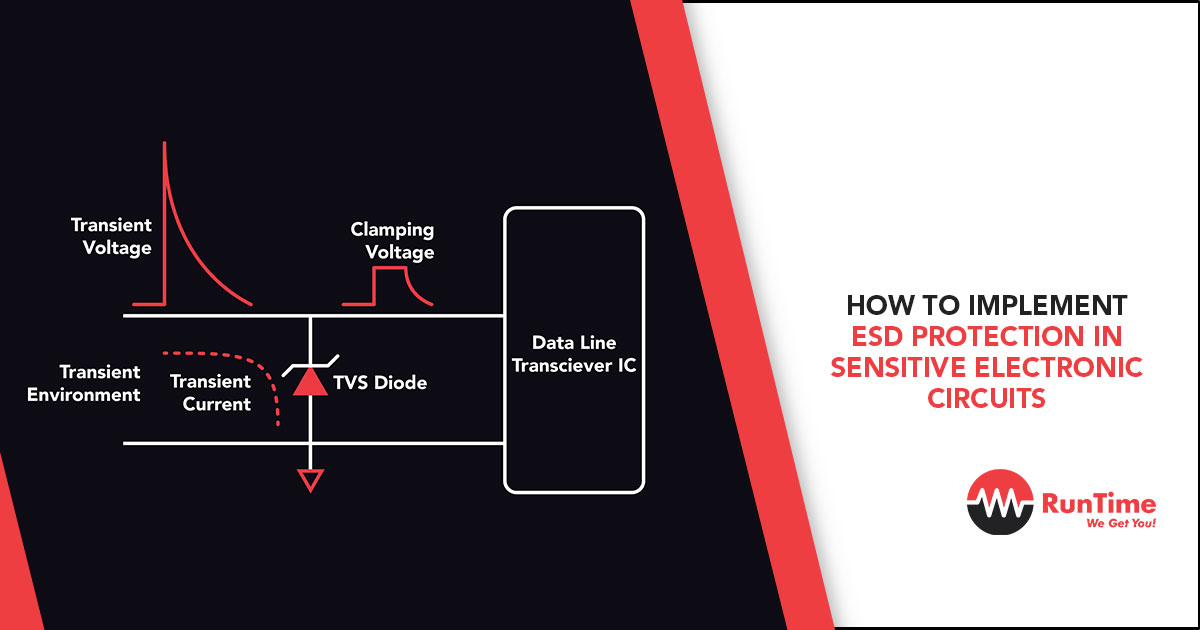Introduction
Electrostatic discharge (ESD) is a common and potentially devastating phenomenon in the world of electronics. It occurs when a sudden flow of electricity between two electrically charged objects, often caused by contact, electrical shorting, or dielectric breakdown, releases energy that can damage sensitive electronic components. For embedded engineers, protecting sensitive electronic circuits from ESD is a critical aspect of design, especially in applications where reliability and longevity are paramount.
This article delves into the principles of ESD protection, the challenges it presents, and practical strategies for implementing effective ESD protection in sensitive electronic circuits. By understanding the mechanisms of ESD and applying best practices, embedded engineers can safeguard their designs against this invisible threat.
Understanding ESD and Its Impact on Electronic Circuits
What is ESD?
Electrostatic discharge (ESD) is the sudden flow of electricity between two objects at different electrical potentials. This can occur when a person walks across a carpet and then touches a metal doorknob, or when two electronic components come into contact during handling or assembly. The discharge can generate voltages ranging from a few hundred volts to several thousand volts, which can easily damage or destroy sensitive electronic components.
How ESD Affects Electronic Circuits
ESD can cause both immediate and latent damage to electronic circuits:
- Immediate Damage: A high-voltage ESD event can cause immediate failure of components, such as burning out transistors, damaging integrated circuits (ICs), or creating short circuits. This type of damage is usually obvious and can be detected during testing.
- Latent Damage: In some cases, ESD can cause partial damage that weakens a component without causing immediate failure. This latent damage can lead to premature failure of the device during its operational life, resulting in costly field failures and reduced reliability.
Common Sources of ESD
ESD can originate from various sources, including:
- Human Body Model (HBM): The most common source of ESD, where a person carrying an electrostatic charge discharges it to a grounded object or electronic component.
- Machine Model (MM): ESD generated by automated equipment during manufacturing or assembly processes.
- Charged Device Model (CDM): ESD that occurs when a charged device discharges to a grounded surface or another device.
Key Principles of ESD Protection
To effectively protect sensitive electronic circuits from ESD, embedded engineers must understand and apply several key principles:
1. Prevention
The first line of defense against ESD is to prevent it from occurring in the first place. This involves controlling the environment and handling procedures to minimize the generation and accumulation of static charges.
2. Diversion
When ESD cannot be entirely prevented, the next best strategy is to divert the discharge away from sensitive components. This can be achieved by providing a low-impedance path for the ESD current to flow, safely bypassing critical circuitry.
3. Absorption
In some cases, it may be necessary to absorb the energy of an ESD event to protect sensitive components. This can be done using components that can safely dissipate the energy without causing damage.
4. Isolation
Isolating sensitive components from potential ESD sources can also provide protection. This can be achieved through physical separation, shielding, or the use of insulating materials.
Practical Strategies for Implementing ESD Protection
1. ESD-Safe Work Environment
Creating an ESD-safe work environment is the first step in protecting sensitive electronic circuits. This involves:
- Grounding: Ensure that all work surfaces, tools, and equipment are properly grounded to prevent the accumulation of static charges. Use grounded wrist straps and footwear to dissipate any static charge from personnel.
- ESD-Safe Materials: Use ESD-safe materials, such as antistatic mats, containers, and packaging, to minimize the generation and accumulation of static charges.
- Humidity Control: Maintain a controlled humidity level in the work environment, as low humidity can increase the risk of ESD. A relative humidity of 40-60% is generally recommended.
2. PCB Layout and Design Considerations
The layout and design of the printed circuit board (PCB) play a crucial role in ESD protection. Consider the following design strategies:
- Ground Planes: Use solid ground planes to provide a low-impedance path for ESD currents. Ensure that the ground plane is continuous and covers as much of the PCB as possible.
- Trace Routing: Route sensitive signal traces away from the edges of the PCB and avoid long, parallel traces that can act as antennas for ESD-induced noise. Use shorter traces and minimize loop areas to reduce susceptibility to ESD.
- Component Placement: Place sensitive components, such as microcontrollers and analog ICs, away from potential ESD entry points, such as connectors and switches. Group related components together to minimize the length of critical signal paths.
- Shielding: Use shielding techniques, such as metal enclosures or conductive coatings, to protect sensitive circuits from external ESD events. Ensure that shields are properly grounded to provide an effective barrier against ESD.
3. ESD Protection Components
Incorporating dedicated ESD protection components into the circuit design is essential for diverting and absorbing ESD energy. Common ESD protection components include:
- Transient Voltage Suppression (TVS) Diodes: TVS diodes are designed to clamp ESD voltages to a safe level, diverting the excess energy away from sensitive components. They respond quickly to ESD events and can handle high surge currents.
- Varistors: Varistors are voltage-dependent resistors that provide ESD protection by clamping the voltage across their terminals. They are commonly used in power supply circuits and I/O lines.
- ESD Suppression Filters: ESD suppression filters combine passive components, such as resistors, capacitors, and inductors, to filter out ESD-induced noise and protect sensitive signals.
- Polymer ESD Suppressors: Polymer-based ESD suppressors are flexible, low-capacitance devices that can be placed directly on signal lines to absorb ESD energy and protect downstream components.
4. Input/Output (I/O) Protection
I/O lines are particularly vulnerable to ESD, as they are often exposed to external connections. To protect I/O lines, consider the following strategies:
- Series Resistors: Place series resistors on I/O lines to limit the current flow during an ESD event. This can help reduce the energy reaching sensitive components.
- Clamping Diodes: Use clamping diodes to limit the voltage on I/O lines to a safe level. Clamping diodes can be integrated into the IC or added as external components.
- Ferrite Beads: Ferrite beads can be used to suppress high-frequency noise generated by ESD events. They are particularly effective in filtering out noise on power and signal lines.
5. Power Supply Protection
The power supply is another critical area that requires ESD protection. Consider the following measures:
- Decoupling Capacitors: Use decoupling capacitors close to the power pins of sensitive components to provide a local energy reservoir and reduce the impact of ESD-induced voltage spikes.
- TVS Diodes on Power Lines: Place TVS diodes on power supply lines to clamp any ESD-induced voltage transients and protect the power supply circuitry.
- LC Filters: Use LC filters on power lines to suppress high-frequency noise and provide additional protection against ESD.
6. Testing and Validation
Testing and validation are essential to ensure that the ESD protection measures are effective. Consider the following testing methods:
- ESD Immunity Testing: Conduct ESD immunity testing to evaluate the circuit’s ability to withstand ESD events. This involves applying controlled ESD pulses to the circuit and monitoring its performance.
- Transient Immunity Testing: Perform transient immunity testing to assess the circuit’s response to fast transient events, such as those caused by ESD.
- Signal Integrity Testing: Use signal integrity testing to verify that the ESD protection measures do not adversely affect the circuit’s performance. This includes checking for signal distortion, noise, and timing issues.
7. Compliance with ESD Standards
Compliance with industry standards is crucial for ensuring the reliability and safety of electronic circuits. Some of the key ESD standards include:
- IEC 61000-4-2: This standard specifies the test methods and immunity requirements for ESD events. It is widely used for testing the ESD immunity of electronic equipment.
- ANSI/ESD S20.20: This standard provides guidelines for establishing an ESD control program in manufacturing and handling environments. It covers aspects such as grounding, personnel training, and ESD-safe materials.
- JEDEC JS-001: This standard defines the test methods for ESD sensitivity testing of semiconductor devices. It is commonly used for characterizing the ESD robustness of ICs.
Conclusion
Implementing effective ESD protection in sensitive electronic circuits is a multifaceted challenge that requires a combination of preventive measures, careful design, and the use of specialized components. By understanding the principles of ESD protection and applying the strategies outlined in this article, embedded engineers can safeguard their designs against the damaging effects of ESD.
Creating an ESD-safe work environment, optimizing PCB layout, incorporating ESD protection components, and conducting thorough testing are all essential steps in ensuring the reliability and longevity of electronic circuits. Additionally, compliance with industry standards provides a framework for achieving consistent and effective ESD protection.
As the complexity and sensitivity of electronic circuits continue to increase, the importance of robust ESD protection cannot be overstated. By staying informed about the latest advancements in ESD protection technologies and continuously refining their design practices, embedded engineers can develop innovative and reliable electronic products that meet the demands of today’s rapidly evolving technology landscape.
In the end, the success of an electronic product hinges on its ability to withstand the challenges of the real world, including the ever-present threat of ESD. By prioritizing ESD protection in their designs, embedded engineers can ensure that their products deliver the performance, reliability, and durability that users expect.









